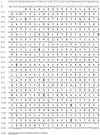Cloning of a hamster anti-mouse CD79B antibody sequences and identification of a new hamster immunoglobulin lambda constant IGLC gene region
- PMID: 23558558
- PMCID: PMC3686505
- DOI: 10.1007/s00251-013-0698-5
Cloning of a hamster anti-mouse CD79B antibody sequences and identification of a new hamster immunoglobulin lambda constant IGLC gene region
Abstract
Anti-CD79 antibodies have been effective at targeting B cell lymphoma cells and depleting B cells in animal models. In order to engineer recombinant antibodies with additional effector functions in mice, we cloned and sequenced the full-length cDNAs of the heavy and light chain of a hamster anti-mouse CD79B antibody. Although hamster antibodies represent a unique source of monoclonal antibodies against mouse, rat, and human antigens, sequence information of hamster immunoglobulins (IG) is sparse. Here, we report a new hamster (Cricetulus migratorius) IG lambda constant (IGLC) gene region that is most homologous to mouse IGLC2 and IGLC3.
Figures






Similar articles
-
Characterization of the bovine immunoglobulin lambda light chain constant IGLC genes.Vet Immunol Immunopathol. 2008 Aug 15;124(3-4):284-94. doi: 10.1016/j.vetimm.2008.04.012. Epub 2008 Apr 22. Vet Immunol Immunopathol. 2008. PMID: 18538861
-
Mouse/human chimeric Me1-14 antibody: genomic cloning of the variable region genes, linkage to human constant region genes, expression, and characterization.Hybridoma. 1994 Apr;13(2):87-97. doi: 10.1089/hyb.1994.13.87. Hybridoma. 1994. PMID: 8050781
-
Cloning of the genes for T84.66, an antibody that has a high specificity and affinity for carcinoembryonic antigen, and expression of chimeric human/mouse T84.66 genes in myeloma and Chinese hamster ovary cells.Cancer Res. 1990 Apr 1;50(7):2128-34. Cancer Res. 1990. PMID: 2107969
-
Antibodies of sharks: revolution and evolution.Immunol Rev. 1998 Dec;166:103-22. doi: 10.1111/j.1600-065x.1998.tb01256.x. Immunol Rev. 1998. PMID: 9914906 Review.
-
Immunoglobulin genes.Mol Immunol. 1980 Nov;17(11):1423-35. doi: 10.1016/0161-5890(80)90012-7. Mol Immunol. 1980. PMID: 6780788 Review. No abstract available.
Cited by
-
Cross-species higher sensitivities of FcγRIIIA/FcγRIV to afucosylated IgG for enhanced ADCC.Antib Ther. 2021 Aug 19;4(3):159-170. doi: 10.1093/abt/tbab016. eCollection 2021 Jul. Antib Ther. 2021. PMID: 34485821 Free PMC article.
References
-
- Alegre ML, Tso JY, Sattar HA, Smith J, Desalle F, Cole M, Bluestone JA. An anti-murine CD3 monoclonal antibody with a low affinity for Fc gamma receptors suppresses transplantation responses while minimizing acute toxicity and immunogenicity. J Immunol. 1995;155:1544–1555. - PubMed
-
- Carter PJ. Potent antibody therapeutics by design. Nat Rev Immunol. 2006;6:343–357. - PubMed
-
- Collins M, Whitters MJ. Hamster cDNA homologs to the mouse immunoglobulin IgG2 constant and Igh-VH10 genes. Immunogenetics. 1995;42:225–226. - PubMed
-
- Ehrenmann FF, Lefranc MP. IMGT/DomainGapAlign: IMGT standardized analysis of amino acid sequences of variable, constant, and groove domains (IG, TR, MH, IgSF, MhSF) Cold Spring Harb Protoc. 2011;2011:737–749. - PubMed
Publication types
MeSH terms
Substances
Grants and funding
LinkOut - more resources
Full Text Sources
Other Literature Sources

